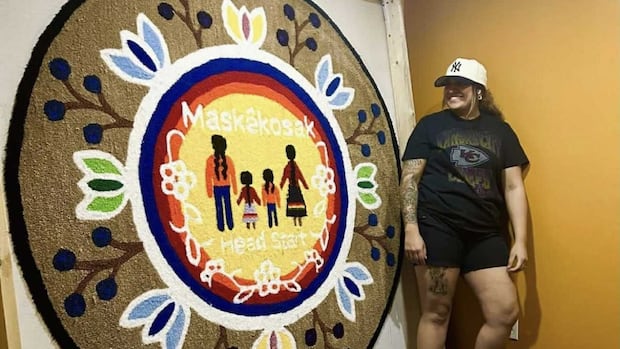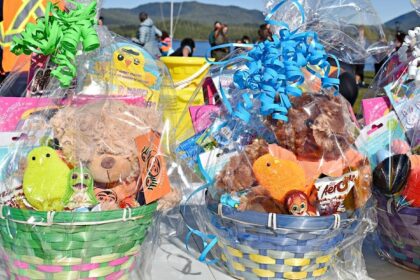IndigenousChastity Shingoose McNab, from Cote First Nation in Saskatchewan, discovered rug making as a hobby to support her mental well-being. She now aspires to teach others, hoping they can also benefit from the craft.Chastity Shingoose McNab says rug making may bruise her hands, but it’s good for her mental healthDarla Ponace · CBC News · Posted: Aug 20, 2025 5:11 PM EDT | Last Updated: 1 hour agoChastity Shingoose McNab standing beside one of the rugs she has made. (Submitted by Chastity Shingoose McNab)By day Chastity Shingoose McNab runs a drywall and taping business called Extreme Trappers Taping, but by night she creates unique customized rugs for a growing Indigenous clientele. “The main thing for me is when people have a smile on their face when they see my rugs or how happy they feel when I deliver a rug,” said Shingoose McNab, who is based in Edmonton.While she currently lives and works in Edmonton, Shingoose McNab is from Cote First Nation in Saskatchewan, about 880 kilometres east of Edmonton and 230 kilometres northeast of Regina.Two years ago, she sought a hobby to support her mental well-being and discovered the art of rug making. Since then, she has created over 20 rugs, all with different shapes, designs, complexities and colours thanks to learning from tutorials on YouTube and TikTok. She makes her rugs by tufting — a craft where yarn is pulled through a base by hand or machine to create different patterns and designs. Shingoose McNab is self-taught and learned from watching YouTube and TikTok tutorials. She hopes to encourage others to take up the art form. (Submitted by Chastity McNab)Though she was interested in rug making for a while, she didn’t pursue it until her partner encouraged her.”It actually wasn’t supposed to be like a business. Like, it was only supposed to be a hobby like to help myself and my mental health,” she said. Hobby helps mental well-beingAs an adult, Shingoose McNab said she has dealt with anxiety, so she was looking for an activity to keep her mind occupied from over thinking.”I was really in a really big rut and I was like, ‘I just need to do something,'” she said. But tufting turned into something much bigger than she expected, she added. Once she bought the materials and tools needed, she took off. Shingoose McNab said each rug takes 50 hours or more to create, and she puts a lot of hard work into each rug.A rug she made for Cote First Nation. (Submitted by Chastity Shingoose McNab)”It’s a lot on your back and with the gun always moving and shaking, it moves like a tattoo gun,” she said.”I’ve worked so hard to where I got bruising on my knuckles because of how my hands were moving on the cloth for so many hours…so it is pretty tough.”Her first rug was for her partner’s eyelash business.”When I first started, like, I was so nervous and nothing was going right. Everything was going wrong,” she said.Her partner told her to take her time, and go smudge with her then try again after that. That’s exactly what she did, and it worked. When it was finished, it was shared online on social media which got attention from people and organizations. Commissions pour inOver the years Shingoose McNab has seen commissions for her work come in from First Nations communities, businesses and people from social media. Cote First Nation Chief George Cote had a rug created for his office with the nation’s emblem on it. “It’s a beautiful rug,” he said.”I have it hanging in my wall in my office.”He said when people come into his office they have nothing but nice things to say, and he’s proud to tell them it was made by a community member.The first rug Shingoose McNab made was for her partners lash business. (Submitted by Chastity Shingoose McNab)”She really loves her work, and she puts a lot into it,” he said. He said all First Nations entrepreneurs across Canada need to keep honing their craft and showcasing their skills. “It’s a tough market out there, and a lot of companies are piggybacking on First Nation opportunities. I’d rather see our own First Nations people being recognized and supported in all the work they do, because it means a lot more,” he said. “Don’t give up, just keep working hard. The more marketing they do, the more successful they will be.”Shingoose said she wants to start teaching youth to help them channel their mental health struggles into something positive.”Life can get hard, but you know there’s always better days ahead,” she said. “I just want to let people know that anything is possible, you know and just take that leap. Don’t be scared to fail because that’s what teaches you in life you have to fail to grow.”ABOUT THE AUTHORDarla Ponace is a Saulteaux woman from Zagime Anishinabek First Nations. She started as an associate producer in the Indigenous Pathways program at CBC. She is currently working with CBC Saskatchewan as a reporter. You can email her at darla.ponace@cbc.ca with story ideas.
Sunday, 21 Dec 2025
Canada – The Illusion
Search
Have an existing account?
Sign In
© 2022 Foxiz News Network. Ruby Design Company. All Rights Reserved.
You May also Like
- More News:
- history
- Standing Bear Network
- John Gonzalez
- ᐊᔭᐦᑊ ayahp — It happened
- Creation
- Beneath the Water
- Olympic gold medal
- Jim Thorpe
- type O blood
- the bringer of life
- Raven
- Wás’agi
- NoiseCat
- 'Sugarcane'
- The rivers still sing
- ᑲᓂᐸᐏᐟ ᒪᐢᑿ
- ᐅᑳᐤ okâw — We remember
- ᐊᓂᓈᐯᐃᐧᐣ aninâpêwin — Truth
- This is what it means to be human.
- Nokoma











